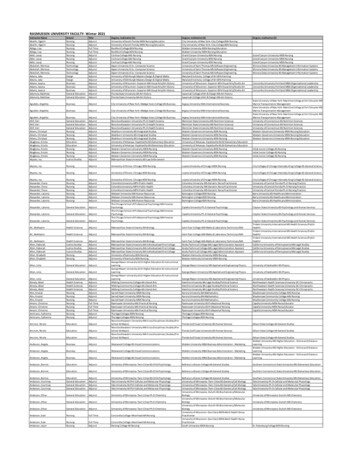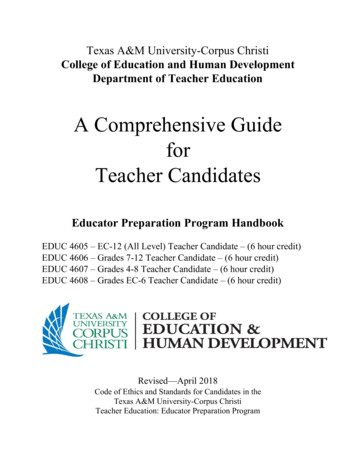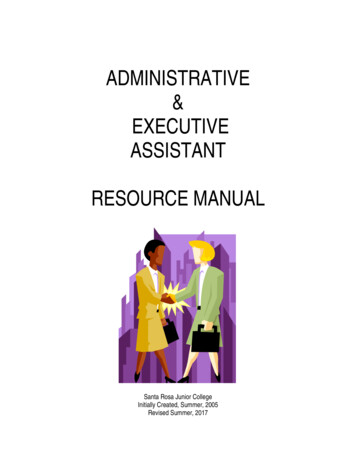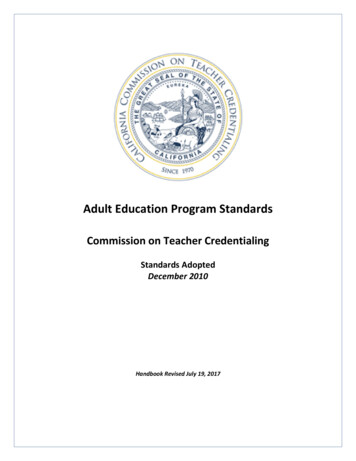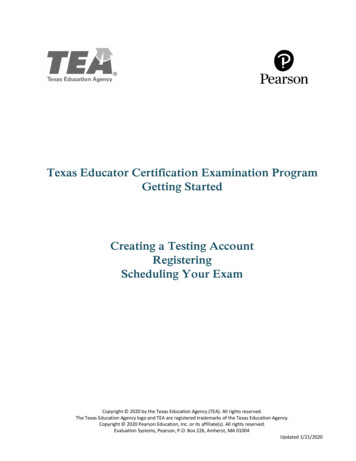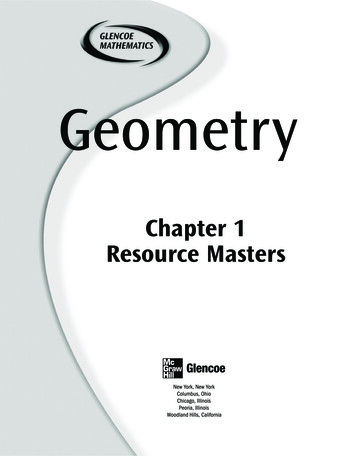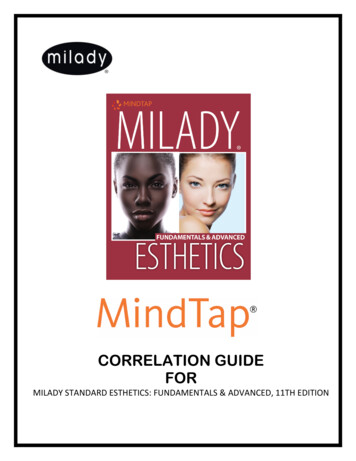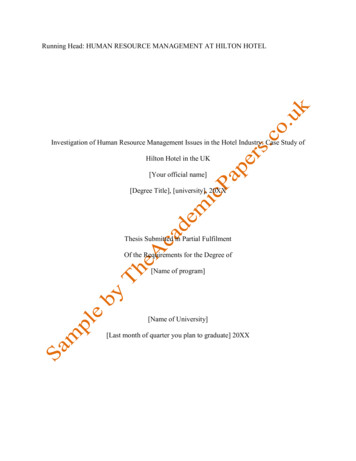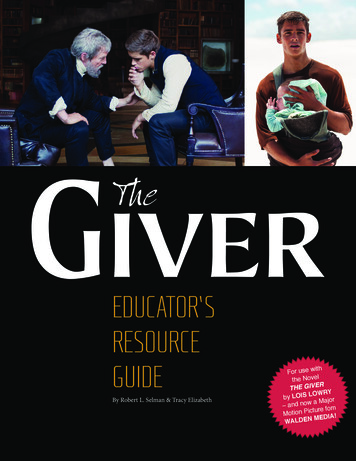
Transcription
EDUCATOR’SRESOURCEGUIDEBy Robert L. Selman & Tracy ElizabethithFor use wethe Nov lRTHE GIVEWO RYby LOIS La Major– and nowture fomMotion PicMEDIA!WALDEN
The Giver Educator’s Resource GuideTable of ContentsTHEORETICAL FRAMEWORK FOR THIS RESOURCE GUIDE . 1PART 1: GETTING TO KNOW THE COMMUNITY . 2PART 2: JONAS’S SELECTION AS RECEIVER OF MEMORY . 7PART 3: JONAS QUESTIONS THE CONVENTIONS OF HIS COMMUNITY . 12PART 4: JONAS REJECTS THE ETHICS OF THE COMMUNITY 17CULMINATING 3E ACTIVITY FOR THE GIVER . 22RECOMMENDATIONS FOR DISCUSSION ACTIVITIES . . 23STRATEGIES FOR FACILITATING HEALTHY DISCUSSIONS . 24ROBERT L. SELMAN is the Roy E.Larsen Professor of Human Development and Education and Professor ofPsychology in Psychiatry at HarvardUniversity; 609 Larsen Hall, 14 AppianWay, Cambridge, MA 02138; email:robert selman@harvard.eduHe conducts research on socialdevelopment and its integration withcurriculum and instruction in elementary and secondary schools and withsocial media, including websites, socialnetworking, and entertainment.TRACY ELIZABETH is a doctoralstudent in the Human Developmentand Education program at HarvardUniversity; 611 Larsen Hall, 14 AppianWay, Cambridge, MA 02138; email:tracy elizabeth@mail.harvard.edu;website: www.tracy-elizabeth.comHer research focuses on the promotionof children and adolescents’ academic, social, and moral developmentthrough education curricula andentertainment media.Excerpts from THE GIVER by Lois Lowry. Copyright 1993 by Lois Lowry. Used by permission of Houghton Mifflin Harcourt.All rights reserved. Page numbers for each excerpt refer to the hardcover edition of THE GIVER, ISBN: 978-0-547-99566-3
The Giver Educator’s Resource Guide3EA Theoretical Framework to Bridgethe Narratives of Books and Films1EducationHow does the story promote critical thinking and deep comprehension?The Education activities are designed to engage youth in rich critical thinking exercises that deepentheir comprehension of content matter and extend their reasoning skills beyond factual inferences fromthe texts. The activities include ways to broaden background knowledge through research, discussion,and writing.EthicsHow does the story promote dialogue and ethical reflection?The Ethics activities are designed to engage youth in high-quality dialogue centered on characters’perspectives and ethical dilemmas presented in and inspired by the texts. They are based on empiricalresearch focused on the promotion of students’ societal-, social- and self-awareness, typically throughunderstanding the thoughts, feelings, and motivations of the characters in the story, as well as their own.2EntertainmentHow does the story promote creativity and capture character identity?The Entertainment activities are designed to engage youth in exercises that align dramatic events inthe film to those in the book, and to nurture young peoples’ creative potential and identification withcharacters in the texts. These activities include methods that empower students to consider how theauthor and screenwriter structured the plot to enhance readers’ and viewers’ engagement with the story.The activities in this resource are appropriate for youth of varying ages and developmental stagesof literacy and social awareness. Nevertheless, all of the questions and concepts introduced herecan be thoughtfully considered by learners across the upper elementary and secondary levels, aswell as by adult learners in college and beyond. Still, we recommend that the educator be awarethat students’ social sophistication and cognitive maturity will play an important part in his orher understanding and interpretation of events in the story.Note: The content on pages 23-25 offers descriptions of the different types of discussion formats,including structured debate, that are conducive to quality dialogue among children and adolescents.For each activity, we recommend that educators select the format that best suits their students.1 Selman, R. L. & Kwok, J. (in press) Counting Hearts and Eyeballs: How to Help Adolescents Make Better Decisions Using Entertainment and theNew Media (and Know that You Have Succeeded). To appear in Kornhaber, M. and Winner, E. ( Editors ) MIND, WORK, AND LIFE: A Festschrift onthe Occasion of Howard Gardner’s 70th Birthday.2 Selman, R. L. (2007). The promotion of social awareness: Powerful lessons from the partnership of developmental theory and classroom practice.New York: Russell Sage Foundation.1
PART 1Getting to Knowthe CommunityEDUCATIONGROUP WRITING:Encourage students to create a Pros & Cons list of Community attributes. What are the good things about Jonas’sCommunity? What are the bad things? Keep this list and add to it as students travel through the story.The CommunityCONS1. There are no wild animals or pets in theCommunity.PROS1. The Community is very orderly.2. People are always polite.2. Youth do not pick their own jobs.3. There is no poverty; everyone has a job.3. Children do not choose their own clothesor styles.PERSONAL WRITING:Ask students to write extended responses to the following questions: Why do you think there are no animalsin the Community? How did this happen? Imagine your own world without animals. How would lifebe different?2
DISCUSSION:Invite students to ponder: What consequences may occur if the following happened in the Community?For each, challenge students to consider what type of punishment, if any, would be assigned. Writing derogatory slurs on a wall Taking someone else’s bike Teasing a sibling for doing poorly on a test Biking to another community Refusing to accept someone’s apologyIRONYIrony is a literary technique that contrasts the expectations of a situation with the events as they actuallyhappen. For example, the way Jonas’s Community uses the term “voluntary” to describe requiredcommunity service is ironic.MUSIC CONNECTION:Invite students to listen to Alanis Morissette’s song Ironic. Encourage them to consider the lyrics and identify someof the ironic situations Morissette references.CIVIC ENGAGMENT:The youth in Jonas’s Community are required to do a certain amount of volunteer work. This is ironic. How cansomeone be required to volunteer? Should volunteer work be required of youth in your community? Why? Pressstudents to justify their argument (their beliefs about how the world operates) with logic or evidence (experiencesthey have had with this type of activity). As a class, develop a service-learning project that you can completeover the course of the year to make a positive difference in your own school or community. Create a list of theproject goals, and include student-generated strategies for ways to ensure that the project will be successful. Askstudents to compare their own program with the volunteerism found in The Giver.3
ETHICSDISCUSSION:Pose the following discussion prompt: What is the significance of rules in Jonas’s Community? Why are somerules socially acceptable, while others are strictly forbidden? For example, we learn that teaching a younger siblingto ride a bike is forbidden, yet happens often and is almost expected within the Community. Alternatively, we laterlearn that hoarding snacks is against the rules and will result in public chastisement.To extend this discussion, encourage students to think of how we learn the rules of our own culture. Invite studentsto make a list of five very important rules in our culture, and then discuss with a partner: Which rules aremore important than others? Why?DEBATE:Divide students into three teams to consider the following dilemma: The Community used shame to reprimandJonas for taking the apple home, yet no one ever spoke of it directly. In fact, a large function in the Community isto avoid disgrace. Ironically, Jonas was publicly, yet privately shamed. Do you think this shaming was a fair wayto address Jonas’s transgression? Team A will argue in favor of Jonas’s punishment. Team B will argue againstit. Encourage students to elaborate on how they know when the punishment fits the crime. Team C, a team ofunbiased judges, will listen to the arguments of the opposing teams and will conclude the debate by offering acollaborative solution that integrates the differing perspectives.DISCUSSION:In the novel, at the family dinner table Lily tells a story about young visitors at her school who do not “obey therules.” Father challenges Lily to take the other children’s perspectives:“I felt very angry this afternoon,” Lily announced. “My Childcare group was at theplay area, and we had a visiting group of Sevens, and they didn’t obey the rules atall. One of them—a male; I don’t know his name—kept going right to the front ofthe line for the slide, even though the rest of us were all waiting. I felt so angry athim ”“Why do you think the visitors didn’t obey the rules?” Mother asked.Lily considered and shook her head. “I don’t know. They acted like like ”“Animals?” Jonas suggested. He laughed.“That’s right,” Lily said, laughing too. “Like animals.” Father was listening with interest. “I’m thinking, Lily,” he said, “about the boywho didn’t obey the rules today. Do you think it’s possible that he felt strangeand stupid, being in that new place with rules he didn’t know about?” [The Giver,pages 6-8]4
Encourage students to come up with strategies that Lily and her classmates could have adopted to make thevisitor feel more welcome and comfortable.To extend the discussion, ask: “From where has the visitor come? What happens when someone moves to a placewhere the customs and rules of society are different?” Then encourage students to share a personal story abouta time in which they were in a similar situation where they felt strange and/or foolish for not knowing therules. How did others make the situation feel better or worse?PERSPECTIVE-TAKING DILEMMA3WRITING:Explain to the class that, in real life, students are faced every day with the kind of situation that Lily shareswith her family unit at dinner. Next, ask them to write their reactions to the scenario below.Imagine that you encounter the following situation:You have lots of friends in your class this year and you are enjoying school. In January, yourteacher introduces a new student to the class, Jariah, who has recently arrived with family froma different city. Jariah’s hairstyle is really strange. Also, your classmates do not like the musicJariah listens to. Some students tease Jariah because they think Jariah is weird.A. Casey is a student who has been witnessing the situation and doesn’t know what to do. Suppose Caseycomes to you for advice.1. What would you recommend to Casey?2. Why would you make that recommendation to Casey?3. What might go wrong with your recommendation?B. Compare this situation to the one Lily reports about the visitors in her school.1. Would Jariah’s situation occur in Lily’s Community?2. How is Jariah’s situation similar?3. How is it different?3 For further information on The Perspective Taking Dilemmas presented in this resource, contact Robert L. Selman at Robert Selman@Harvard.edu5
ENTERTAINMENTREADER’S MOVIE THEATER:In both the book and film, we get a sense of the characters’ apprehension as they prepare for the ceremony inwhich they will be assigned jobs. Consider the following excerpt from the screenplay:ASHER:So this is it. Last night of childhood.FIONA:I guess everything is going to be different.A moment of hesitation.JONAS:No. Tomorrow, the only thing that changes is what we do. But what doesn’t changeis who we are.ASHER:(Smirks) Quick question: Who are we?JONAS:Well, I guess, we’re the three of us. I mean, we always have been.FIONA :(Overly grand) And so we always shall be.They laugh.ASHER:Friends. Even when you’re both assigned to be Birth Mothers DISCUSSION or WRITING:Encourage students to reflect upon the following questions:1. Why would Asher be worried that this is their last night of childhood? And, do you think Jonas’sresponse is comforting to Asher and Fiona? Why?2. How do friendships change across the duration of the story? What causes these changes?3. With which character in the story do you most closely identify or sympathize? Why?6
PART 2Jonas’s Selection asReceiver of MemoryWhat is a Turning Point?A character’s turning point is a moment within the story where the character changes his thoughts,feelings, or attitudes. This change is typically inspired by conflict. Other times, a turning point is ignitedduring moments when the character has encountered a crisis or learned something important enough tochange his outlook and the story’s direction.CHARACTER TURNING POINTAfter Jonas learns that he has been selected to be theReceiver of Memory, he experiences mixed feelingsof both pride and fear. How does this selection changeJonas? For the first time ever, Jonas learns what it’slike to feel different and slightly alienated fromhis Community.7
EDUCATIONDISCUSSION:Ask students to consider: Why are Jonas and others in the Community only exposed to a limited set of books(dictionaries, descriptions of Community offices, lists of Rules, etc. [The Giver, page 94])? What types of reading,if any, did they do in school? How would the absence of fiction and historical texts affect Jonas’s life?Ask students to reflect on the following: How would the absence of fictional stories affect your life, personality,and perspective of the world? What about the absence of historical texts?DISCUSSION:Invite students to imagine the possible discipline issues that occur during an average week at Jonas’s school. Inwhat ways would students in the Community break the rules? What behaviors are considered to be seriousinfractions at Jonas’s school? How do you imagine these discipline issues are resolved? Who handles them?CREATIVE HISTORY:Encourage students to use their imaginations to create a timeline of major historical events that happened inJonas’s Community over the past 100 years. Ask them to provide titles and brief summaries of each event, andto illustrate key moments.WRITING:Remind students of the five qualities that a Receiver must have: Intelligence, Integrity, Courage, Wisdom, andthe Capacity to See Beyond. Describe what each of these traits means to you and identify examples of waysone may demonstrate them.To extend this exercise, ask students to rank order the most to least important of the character traits noted above.Encourage them to justify why they view some traits are more valuable than others.WRITING & DISCUSSION:Jonas gets a startling new set of rules along with his new “job.” On poster board or chart paper, ask students towrite down the list of Jonas’s new rules. Next, ask students why they believe Jonas received these particularrules. What might their different purposes be?Keep this list posted and return to it when students have completed the story. Consider how the significance ofeach rule changes as the story progresses.WRITING:Continue to add to your list of Pros & Cons of the Community. What are the good things about it? What are thebad things? Make a note of things that you change on your list and explain why you have changed your mind abouttheir value.8
ETHICSDISCUSSION:Talk with students about the difference between being assigned a job versus being selected for a job. Ask: Why isbeing “selected” thought of as more of an honor, if one cannot really refuse the selection?DEBATE:Jonas is most struck by the new rule that he is allowed to lie. Consider the following excerpt from the book:Finally he steeled himself to read the final rule again. He had been trained sinceearliest childhood, since his earliest learning of language, never to lie. It was anintegral part of the learning of precise speech. Once, when he had been a Four,he had said, just prior to the midday meal at school, “I’m starving.”Immediately he had been taken aside for a brief private lesson in language precision. He was not starving, it was pointed out. He was hungry. No one in thecommunity was starving, had ever been starving, would ever be starving. To say“starving” was to speak a lie. An unintentional lie, of course. But the reason forprecision of language was to ensure that unintentional lies were never uttered. He had never, within his memory, been tempted to lie. Asher did not lie. Lilydid not lie. His parents did not lie. No one did. Unless Now Jonas had a thought that he had never had before. This new thought wasfrightening. What if others—adults—had, upon becoming Twelves, received intheir instructions the same terrifying sentence?What if they had all been instructed: You may lie?His mind reeled. [The Giver, hardcover edition, pp. 70-71]DEBATEOPTION #1Divide students into three teams to consider the following: Why is permission to lie particularly startling to Jonas?How does lying affect others in the Community? Next, ask the teams to debate the following topic: Is there evera time in your own life when it is okay to tell a lie? And is there a difference between a big lie and a little lie?Team A will argue against lying; Team B will argue that lying is often harmless and necessary for good. Team C,a team of unbiased judges, will listen to the arguments of the opposing teams and conclude the debate by offeringa collaborative solution that integrates differing perspectives that were introduced.9
DEBATEOPTION #2Divide students into three teams and challenge them to contemplate the following: Consider the concept of “lying”from a larger societal perspective. What if a society found a way to get rid of lying in the community? Imagine asociety that requires everyone to wear a lie detector device at all times. If the detector found out that someonehad lied, the information would go to the authorities (teachers, police, or judges). Is this a good idea? TeamA will argue that the mandatory use of lie detectors is a violation of human rights and would be harmful to thesociety; Team B will argue that the mandatory use of lie detectors would eliminate harmful dishonesty and crime,therefore enhancing the safety and harmony of the society. Team C, a team of unbiased judges, will listen to thearguments of the opposing teams and conclude the debate by offering a collaborative solution that integratesdiffering perspectives that were introduced.DEBATE:The Elders decided long ago to adopt Sameness, Climate Control, etc. to protect its members. Consider why theElders would make this choice, then think of your own world. What would you do if you were a town leader whowanted to protect your citizens from suffering? Divide students into three teams to debate the following: Howmuch protection should a community offer and how much autonomy and choice should citizens have? TeamA will advocate for Sameness as an effective and humane way to protect the Community, while Team B will opposeSameness as a cruel and oppressive form of dictatorship. Team C, a team of unbiased judges, will listen to thearguments of the opposing teams and conclude the debate by offering a collaborative solution that integrates thediffering perspectives that were introduced.To extend this activity, ask each team to make a list of both the advantages and disadvantages of Sameness and toagree as a team what the greatest risk and greatest benefit would be. Then, as a whole class, compare lists.DISCUSSION:Jonas’s new set of rules allows him to behave in ways that go against many norms in his Community’s culture.Encourage students to think of culturally confusing or “foreign” norms they have encountered in their own lives.(For example, in America, it is quite rude to slurp your soup at the dinner table, but in Japan this is a sign that youare enjoying the meal. A more common example may be that at your own house, you are allowed to wear shoesinside, yet at a friend’s house you are required to take your shoes off before entering.) Ask: Have you ever been ina situation where the “norms” or “rules” were different than what you were accustomed to? How did this makeyou feel? What did you do to adapt to this difference?ENTERTAINMENTSCREENWRITER’S PURPOSE:Why, as Jonas receives memories from the Giver, does the movie transition from black and white to color?What parts of the story inspire color? (Possible response: The more memory and emotion Jonas gets, the morecolorful and rich his life appears to be.)READER’S MOVIE THEATER:When the Giver meets Jonas for the first time, he tells Jonas that with memory comes pleasure and pain. Jonaslearns that the Receiver of Memory’s role is to provide guidance to the Council of Elders by evoking wisdom from10
the memories of the past. Consider the following excerpt from the screenplay, where Jonas experiences his firstmemory (snow sledding), and then questions why others in the Community can’t have memories:JONAS:Well Why why don’t we have [Struggling to find the words.] That thing—GIVER:Come on. The memories gave you the words. It’s not a “THING.” It’s a GIVER: Sled.JONAS: Sled.JONAS:And the the GIVER:Snow.JONAS:Snow. Did my parents have them? Did you?GIVER:No, it’s a very distant memory. Simply stated, there’s no snow because of climatecontrol.JONAS:But but why don’t people KNOW about them? What’s so dangerous about thememory of a SLED?GIVER:What’s so dangerous? [He scoffs.] For a sled you need snow. But snow is cold.Cold destroys crops. Which meant farmers can’t farm, people can’t eat, thencomes hunger, starvation, famine Everything is connected. Everything is abalance. With good there is always bad. The two are—He intermingles his fingers. JONAS barely hears THE GIVER.JONAS:[Expectant, rolling up his sleeves.] Show me more.DISCUSSION or WRITING:Encourage students to reflect upon the following questions:1. What does it mean that with memory comes pleasure and pain? Is memory worth the pain? Explain.2. This scene gives us some explanation for why the Elders adopted Climate Control. How do you feelabout this decision? Do you believe Climate Control would benefit our society?3. What memories of the past have helped you to make wise decisions in the present? How?11
PART 3Jonas Questionsthe Conventions ofHis CommunityCHARACTER TURNING POINTJonas challenges Sameness; he struggles to understand why the Community has adopted Sameness asa cultural norm. Jonas argues that the Communityshould not have taken differences away.EDUCATIONWRITING:Challenge students to consider how schooling is portrayed in the story. What types of subjects do Jonas and hispeers study in school? Consider the following excerpt from the book:School seemed a little different today. The classes were the same: language andcommunications; science and technology; civil procedures and government. Butduring breaks for recreation periods and the midday meal, the other new Twelveswere abuzz with descriptions of their first day of training.[The Giver, page 112]12
Compare Jonas’s classes to your own. How are the subjects similar? Different? Further, think about what it meansto be a teacher in the Community. Put yourself in the shoes of two characters from the story and write aboutwhat typical school day in the Community would be like for each of them.RESEARCH:When he is first learning about memory, Jonas wants to remember the experience of sledding again, but he isconfused by how to do this. The Giver tells Jonas to “call back the memory of the ride on the sled.” [The Giver, page117] Jonas did not realize that he could retrieve his own memories without the help of The Giver. How do ourbrains actually work to save memories? What is the difference between short-term and long-term memory?PREDICTIONS:Given what you know about Jonas’s ability to “see beyond,” what do you think “hearing beyond” would mean?WRITING:Jonas gets upset when children are playing war with imaginary weapons, attacks, and death. “Don’t play it anymore It’s a cruel game,” Jonas pleads with Asher. (The Giver, page 168) Why does Jonas react this way? Do youagree that children shouldn’t “play” war? How do you feel about other media (video games, music videos, etc.)that portray violence?WRITING:Continue to add to your list of Pros & Cons of the Community. What are the good things about it? What are the badthings? Make a note of things that you have changed on your list and explain why you have changed your mind abouttheir value. Many readers tell us that the more they deeply think about this story and discuss it with others, the morethey begin to see how much we take for granted in our own society. When reading The Giver, one begins to learn thatthe rules of the Community are actually intended to alleviate the same types of pains and problems we face in ourown world.ETHICSDISCUSSION:About midway through the story, we see that Jonas begins to question the conventions of his Community. Considerthe following excerpt from the book:“It isn’t fair that nothing has color!”“Not fair?” The Giver looked at Jonas curiously. “Explain what you mean.”“Well ” Jonas had to stop to think it through. “If everything’s the same, thenthere aren’t any choices! I want to wake up in the morning and decide things!”[The Giver, pages 122-3]Ask students to discuss: What does it mean to have choice? In Jonas’s Community, is choice a luxury or is it aburden for its members? Explain.13
To extend, challenge students to contemplate: When could too many choices be problematic? Alternately, if noone in the society has choices, would it still be unfair not to have choices?DISCUSSION:Jonas feels compelled to ask his parents if they love him. Consider the following excerpt from the book:“Father? Mother?” Jonas asked tentatively after the evening meal. “I have aquestion I want to ask you.”“What is it, Jonas?” his father asked.He made himself say the words, though he felt flushed with embarrassment.He had rehearsed them in his mind all the way home from the Annex.“Do you love me?”There was an awkward silence for a moment. Then Father gave a little chuckle.“Jonas. You, of all people. Precision of language, please!”“What do you mean?” Jonas asked. Amusement was not at all what he hadanticipated.“Your father means that you used a very generalized word, so meaningless thatit’s become almost obsolete,” his mother explained carefully.Jonas stared at them. Meaningless? He had never before felt anything asmeaningful as the memory.“And of course our community can’t function smoothly if people don’t use preciselanguage. You could ask, ‘Do you enjoy me?’ The answer is ‘Yes,’” his mother said.“Or,” his father suggested, “ ‘Do you take pride in my accomplishments? And theanswer is wholeheartedly ‘Yes.’”“Do you understand why it’s inappropriate to use a word like ‘love?’” Mother asked.Jonas nodded. “Yes, thank you, I do,” he replied slowly. [The Giver, pages 159-60]This leads to an awkward moment for the whole family. How do Father and Mother’s responses make Jonas feel?How does Jonas’s question make his parents feel? What significance does the absence of love have on theCommunity as a whole? On its individual members?DEBATE:Every time a memory is passed on to Jonas, the Giver permanently forgets that memory. This means that Jonas hasthe ability to take away much of the Giver’s pain by taking more and more of the Giver’s painful memories. We seean example of this in the story when the Giver is crippled by his sad memories of wartime and human suffering.14
Both characters are confronted by a dilemma: Should the Giver transfer horrible pain (such as the memory of war)to Jonas in order to save himself? And should Jonas agree to take on anguish just to help the Giver?Divide students into three teams to debate the following: Even though the Giver is technically required to transfer all memories to the Receiver, both good and bad, is this absolutely necessary? Should the Giver decide whatmemories to transfer? Team A will argue that the Giver must transfer all memories, happy and sad, to The Receiverin order to preserve them forever. Team B will argue that the sad and painful memories are not healthy or helpfulto the Receiver and therefore the Giver should not transfer those memories. Team C, a team of unbiased judges,will listen to the arguments of the opposing teams and conclude the debate by offering a collaborative solution thatintegrates the differing perspectives that were introduced.DEBATE:Rosemary, the former Receiver-in-training, experienced memories of poverty, hunger, and terror. She was so overwhelmed by these memories that she asked the Chief Elder if she could be released. What type of relief, if any, didRosemary expect from her release? What other options did Rosemary have within the Community for coping withher immense new sadness? Divide students into three teams to debate the following: When Rosemary requestedher own release, was this suicide? Team A will argue that Rosemary, by willingly requesting her own release, didcommit suicide. Team B will argue that Rosemary did not commit suicide, as she may not have been aware of theconsequences brought upon by release. Team C, the team of judges, will listen to the arguments of the opposingteams and conclude with a collaborative solution that integrates the differing perspectives that were introduced.ENTERTAINMENTCHARACTER TURNING POINTSThis is a turning point for Jonas and Fiona. Jonasdecides to revolt against his Community and Fionaagrees to break the rules of the Community.READER’S MOVIE THEATER:In the story, Jonas decides to secretly stop taking his medicine. As a result, his senses and emotions are heightened.In the film, Jonas outsmarts the Community by dabbing some of his own blood on an apple to trick the sensor intothinking it is his finger. Next, Jonas convinces Fiona to also stop taking her medicine:JONAS:What do you think would happen if you skipped your morning injection? Ifyou skipped it.FIONA:The Sensor would blink and remind me that I forgot it.JONAS:I don’t mean
Page numbers for each excerpt refer to the hardcover edition of THE GIVER, ISBN: 978-0-547-99566-3 ROBERT L
